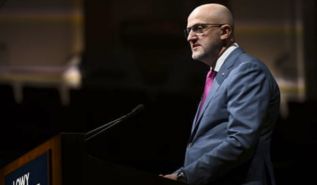بسم الله الرحمن الرحيم
The United States at the Crossroads of a Great Division
(Translated)
https://www.alwaie.org/archives/article/20032
Al Waie Magazine Issue No. 471
Thirty-Ninth Year, Jumada I 1447 AH corresponding to October 2025 CE
The United States is currently witnessing an unprecedented wave of protests, dubbed the “No Kings protests,” in more than two thousand cities and towns. Seven million demonstrators took to the streets on October 18th, raising simple slogans, such as, “No Dictators” and “No Tyrants.” However, behind the slogans lies a deeper reality: the exposure of domestic fissures, that several American research centers have described for years, as the harbingers of a cold civil war rapidly escalating into open conflict.
The current protests are not a passing event, but a new link in a chain of escalating social and political tensions that have persisted for two decades. Political polarization between Republicans and Democrats has reached levels that the Brookings Institution has described in its op-ed “Dangerous cracks in US democracy pillars” of 13 February 2025, as “growing threats to US democracy posed by the new Trump administration.” The disagreements today are no longer about policies, but about the very identity of the nation: who represents “the real America,” what citizenship means, and what values govern the relationship between the state and the individual.
Beneath this sharp political divide lie other layers of tension: an unprecedented class gap in US history, where the wealthiest 1% of the population owns as much wealth as the remaining 99% combined, according to data from the Pew Research Center and the Federal Reserve. This gap, as studies by Brookings, CSIS, and RAND have shown, is no longer merely an economic indicator, but a volatile social force, fueling resentment, nihilism, and a loss of trust in institutions.
At the level of public trust, studies from Harvard Kennedy School indicate that less than 20% of Americans trust the federal government. With the rise of violent rhetoric in the political and media spheres, the gap between citizens and the state has widened, while social media has become a platform for psychological mobilization, ripe for explosion.
Historically, empires do not collapse when they are defeated abroad, but rather when they fail to manage their internal contradictions and challenges. The United States today faces a simultaneous erosion of three pillars that once constituted its strength: domestic confidence, economic supremacy, and soft power. Society is torn between a financial elite that monopolizes wealth and a public that believes the “American Dream” has faded. The economy is burdened by a national debt that has reached $37.5 trillion, an increase of $2.5 trillion in just 12 months, while faith in the values that shaped America's very image is waning.
From this perspective, it can be argued that what is happening in the streets of the United States is not a protest against a political decision, but rather a popular referendum on the future of the American entity. If this trend toward polarization continues, the country may enter a phase of “structural tension” that typically precedes societal explosion or a soft federal split. The scenarios may vary between open civil war and a dual, antagonistic system within a single state, but what is certain is that “old America” is disintegrating at a faster pace than its official rhetoric suggests.
Ultimately, one doesn’t need a predictive forecast to realize that the United States, as Princeton and RAND studies have warned, is nearing a point of no return in its domestic conflict: between an overbearing central authority and a people demanding the restoration of their republic. These protests are merely the first harbinger of a historical transformation that could reshape America and the world along with it.




